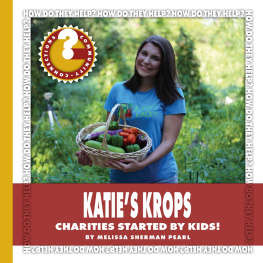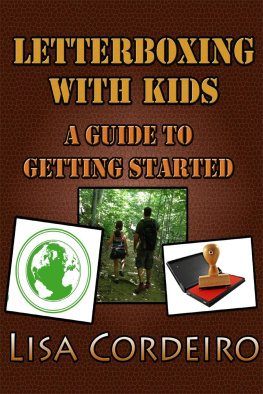Table of Contents
Guide
Published in the United States of America by Cherry Lake Publishing
Ann Arbor, Michigan
www.cherrylakepublishing.com
Reading Adviser: Marla Conn MS, Ed., Literacy specialist, Read-Ability, Inc.
Photo Credits: Photo used with permission from Katies Krops, cover, 7, 11, 13, 15,
17, 19, 21; Rawpixel.com/Shutterstock Images, 5; Monkey Business Images/
Shutterstock Images, 9
Copyright 2018 by Cherry Lake Publishing
All rights reserved. No part of this book may be reproduced or utilized in any form
or by any means without written permission from the publisher.
LIBRARY OF CONGRESS CATALOGING-IN-PUBLICATION DATA HAS BEEN
FILED AND IS AVAILABLE AT CATALOG.LOC.GOV
Cherry Lake Publishing would like to acknowledge the
work of The Partnership for 21st Century Learning. Please
visit www.p21.org for more information.
Printed in the United States of America
Corporate Graphics
CONTENTS
4 Some Ingredients Are Bigger
Than Others
14 Your Wish (and Krop) Will Be
Granted
SOME INGREDIENTS
ARE BIGGER THAN
OTHERS
Food insecurity is defined by the
United States Department of
Agriculture as the occasional lack
of access to enough food for the
household. According to statistics,
one out of every six people in
America faces hunger.
Families with children are more at risk of hunger than
families without children.
Katie Stagliano and her family
have always been grateful for their
life in South Carolina. Many
dinner conversations focused
on how lucky they were to
enjoy a healthy meal together
every night as many families
went to bed hungry. In 2008,
when Katie grew an amazing
40-pound (18-kilogram) cabbage
from a seedling received in her
third grade class, she knew it was
something special.
Katie and her family were fortunate, but 17% of South
Carolinas population lives in poverty.
THINK!
Katie firmly believes
that it doesnt matter
how small your
actions are. They may
still have a ripple
effect and help other
people. Whats a
small thing you can
do to help change
someones life for the
better?
SHARING IS CARING
Katie, age 9, started thinking
about what she could do with this
outstanding bounty . The cabbage
was far too large for her and her
family to eat. She decided to
donate it to her local soup kitchen.
The kitchens director suggested she
come back to help serve the meal.
Two days later, she returned
and got to serve 275 guests. She
couldnt believe that one not-so-little
Soup kitchens helped many people in America during
the Great Depression.
cabbage helped feed so many. This
experience changed her life. It
inspired her to create Katies Krops,
a youth-run collection of gardens
that donates their harvests
to organizations that feed the
hungry.
Before there was a nonprofit,
though, there was Katies next
garden. She asked her parents if
they could start a garden in their
yard and continue helping the soup
kitchen. They, of course, said yes.
Tomatoes are actually a fruit and not a vegetable.
MAKE A GUESS!
Katies 40-pound
(18-kg) cabbage
helped feed
275 people. If the
average cabbage
weighs about
2 pounds (1 kg),
how many would you
need to feed the same
number of people?
Their encouragement inspired her to
write a letter to her school explaining
what shed done with her cabbage as
well as her goal. By fourth grade,
her school gave her a plot of land
the size of a football field to plant
a garden.
The average American eats about 400 pounds
(181 kg) of vegetables each year.
YOUR WISH
(AND KROP) WILL
BE GRANTED
Creating two gardens wasnt enough
for this budding philanthropist .
With support from her community
as well as from kids across the
country, she needed to do more. She
resolved to offer grants to kids ages
9 to 16 so they could grow gardens
in their own communities and donate
the fresh produce. This would feed more
Growing a vegetable garden can take a lot of
patience and practice.
LOOK!
Katies Krops uses
ladybugs to eat bugs
that can harm the
harvests. What other
kinds of organic
gardening practices
can be used on
gardens? Take a
look online or at the
library to find the
answers.
people while empowering kids to help
others.
To apply for a grant, kids create
written proposals answering a number
of questions. Where would they grow
their garden? Who would help them
with it? Where would their harvests
be donated? Katie and her mom,
Stacy, wanted to understand what the
kids gardens would be like and make
sure there was a maintenance plan.
Once approved, the kids receive
many helpful tools. Gift cards to local
Compost is made by recycling food- and yard-waste to
make healthy soil that helps plants grow.
ASK QUESTIONS!
Compost is used to
help make soil better
and grow more
nutritious vegetables.
Katie has compost
bins set up at home
and at school. Do
any of your friends or
family use compost
in their yards? Ask
them about it.
garden supply stores, a growers manual,
and support from a master gardener are
just a few. Gardens began to blossom
in Massachusetts, Wisconsin, Georgia,
and a few other states in 2009.
Not long after launching her
nonprofit, the only soup kitchen in
Katies community shut down. She
recognized that her gardens could
offer a solution and started Katies
Krops Dinners. Once or twice a
month, Katie and her volunteers serve
meals prepared primarily with the
Many people volunteer at soup kitchens during the
holidays. But these organizations need help year round.
ASK QUESTIONS!
Have you ever helped
in a soup kitchen?
Have your friends or
family? Talk to them
and find out. Maybe
you could all do it
together.
harvest from their gardens to anyone in
need.
As of 2017, there were more than
100 gardens in 33 states. These
gardens have fed thousands of
people. Currently a college student,
Katie remains very active in the
charity she cultivated , while Stacy
takes care of the charitys day-to
day needs. Katie returns home for
the Katies Krops Dinners, reviews
grant proposals, and never misses a
chance to garden locally.
Katies favorite crop to grow is a cabbage. Her favorite
to eat is eggplant. What is your favorite vegetable?
CREATE!
Grow something!
Some vegetables can
be grown in small
pots indoors. Start
your own kitchen
garden with vegetable
seeds and small jars
or pots. What yummy
veggies do you want
to grow?
GLOSSARY
bounty (BOUN-tee) something, such as crops, that exists in
generous amounts
cultivated (KUHL-tuh-vay-tid) promoted the growth and development
of something
empowering (em-POU-ur-ing) helping someone believe they are
powerful and can change things or go after their dreams
grants (GRANTS) sums of money to be used for a particular purpose
harvests (HAHR-vists) crops that have been gathered at the end of a
growing season
maintenance (MAYN-tuh-nuhns) care and upkeep
philanthropist (fuh-LAN-thruh-pist) a person who works to promote










